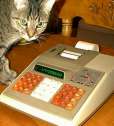NOMA PR-100
| Datasheet legend
Ab/c:
Fractions calculation
AC: Alternating current BaseN: Number base calculations Card: Magnetic card storage Cmem: Continuous memory Cond: Conditional execution Const: Scientific constants Cplx: Complex number arithmetic DC: Direct current Eqlib: Equation library Exp: Exponential/log functions Fin: Financial functions Grph: Graphing capability Hyp: Hyperbolic functions Ind: Indirect addressing Intg: Numerical integration Jump: Unconditional jump (GOTO) Lbl: Program labels LCD: Liquid Crystal Display LED: Light-Emitting Diode Li-ion: Li-ion rechargeable battery Lreg: Linear regression (2-var. stats) mA: Milliamperes of current Mtrx: Matrix support NiCd: Nickel-Cadmium recharg. batt. NiMH: Nickel-metal-hydrite rech. batt. Prnt: Printer RTC: Real-time clock Sdev: Standard deviation (1-var. stats) Solv: Equation solver Subr: Subroutine call capability Symb: Symbolic computing Tape: Magnetic tape storage Trig: Trigonometric functions Units: Unit conversions VAC: Volts AC VDC: Volts DC |
| ||||||||||||||||||||||||||||||||||||||||||||||||||||||||
NOMA PR-100
[NB: One user reports that his PR-100 is powered by a single CR2016 lithium button cell.]
 I am holding in my hands a calculator that manages to be most unusual and most common, all at the same time.
I am holding in my hands a calculator that manages to be most unusual and most common, all at the same time.
It is unusual because it is the first ever programmable calculator I've seen under the NOMA brand name, and also the first out of Poland (at least I believe that Kalkulator programowalny, seen on the machine's back label, is Polish for programmable calculator.) Although I do not know the precise date of its manufacture, some of its characteristics, such as the hand-written serial number on the back, or the green wax warranty seal over one of the (flatblade, not Phillips) screws suggest that it was still manufactured in a factory owned by the Communist state, or perhaps was made shortly after the transition to a market economy. [Update: a user reports that his PR-100 was manufactured in December 1989.]
So what makes it common, then? It uses a calculator chip that is perhaps the most widely used in OEM or store label programmable calculators world-wide. Right at this moment, I am staring at a collection of no fewer than fourteen different calculators (two Citizens, an Aurora, a Privileg, an MBO, an Ibico, an MCI, a Knight, an Intertronic, a PiraComp, two Radio Shacks and a Walther brand machine in addition to this NOMA PR-100), all of which appear very different, all of which are functionally identical, having the same Sharp LI3301A calculator chip inside.
The programming model of this calculator chip is rather limited. Only 40 steps are available, fewer if you use the calculator's memories. No conditionals or branching, and you have to cope with that dreaded "feature" of the X-register being zeroed out whenever you switch to Learn mode, making it impossible to enter an algorithm that yields an error for a null argument.
Even so, the calculator has enough "juice" for a low accuracy implementation of the Gamma function using Stirling's formula:
x-M 1 M+ ÷ RM ÷ 1 2 + 1 = × RM yx RM ÷ RM ex × ( 2 × π ÷ RM ) √ =


